-
Publish Your Research/Review Articles in our High Quality Journal for just USD $99*+Taxes( *T&C Apply)
Offer Ends On
Suchanda Sahu*, Athipatla Keerthi and Joseph John
Corresponding Author: Suchanda Sahu, Department of Biochemistry, Additional Professor, All India Institute of Medical Sciences (AIIMS), Bhubaneswar, Odisha, India.
Received: May 08, 2024 ; Revised: May 17, 2024 ; Accepted: May 20, 2024 ; Available Online: May 28, 2024
Citation: Sahu S, Keerthi A & John J. (2024) A Study to Assess the Knowledge, Attitude and Practices of Young Indian Women Towards the Presence of Lead and other Heavy Metals in Cosmetics. J Pharm Sci Drug Discov, 3(1): 1-8.
Copyrights: ©2024 Sahu S, Keerthi A & John J. This is an open-access article distributed under the terms of the Creative Commons Attribution License, which permits unrestricted use, distribution, and reproduction in any medium, provided the original author and source are credited.
Views & Citations
Likes & Shares
Cosmetics used by women for personal care and altering appearance are known to contain heavy metals as additives or contaminants. They are absorbed and accumulate in the body with prolong use and pose several health hazards. This study was conducted to assess the knowledge, attitude and practices of toxic elements in cosmetics among women who are the larger consumers. The observations revealed that there was lack of knowledge among young educated women about heavy metal contaminants and its health hazards. This presses a compelling need to investigate further in larger groups involving all strata of women and men. There is a need to conduct campaigns at production and regulatory levels to manufacture and market cosmetics and personal care products which have safe levels of contaminants.
INTRODUCTION
It is an age-old practice to use cosmetics for personal hygiene and beautification. Depending on the local traditions and practices they are prepared and used either on special occasions or as a routine. Nowadays, a variety of products prepared from natural and synthetic ingredients are available in the market.
Cosmetic is defined under section 3(aaa) of the Drugs and Cosmetics Act, 1940 as, any article intended to be rubbed, poured, sprinkled or sprayed on, or introduced into, or otherwise applied to, the human body or any part thereof for cleansing, beautifying, promoting attractiveness or altering the appearance, and includes any article intended for use as a component of cosmetics. It is widely used by all age groups, more so by women.
Sipahi [1] studied the content of cadmium (Cd), lead (Pb), and nickel (Ni) in 105 hair care products commercially available in Turkey. They detected that Cd, Pb, and Ni were in 40%, 21.91%, and 94.29% of the samples, respectively. Deeb [2] reported a case of length-dependent sensory axonal polyneuropathy due to lead exposure from hair dye used for coloring his beard. He had a full recovery after stopping the lead-containing product.
Nourmoradi [3] analyzed fifty samples of lipstick (5 colors in 7 brands) and eye shadow (3 colors in 5 brands) available in Iran, for lead and cadmium and commented that prolonged use of these cosmetics can lead to considerable absorption and storage in the body. They a particularly harmful in pregnant women and children. Malvandi [4] estimated Pb, Cd, and Cr in 7 brands of lipstick samples available in Iran. Though manufactured in different countries. They reported significant difference in concentration of heavy metals among the brand and that all of them were below the international standards for lipsticks. However, they concluded that, due to the simultaneous use of lipstick with other types of cosmetics there can be potential exposure of toxic elements to the consumers, and have recommended to discontinue the use of these types of products to avoid potential health risks. In another experiment conducted by Zhao [5], they inferred that the calculation of Pb intake based on relative bioavailability (Pb-RBA) showed that lip product ingestion contributed 5.4-68%, which can pose a potential health risk to women. In contrast, Torres [6] commented that at the concentrations of Pb and Cd present in lipsticks, there was a total cancer risk less than 1. The lipsticks available in the US market were analyzed by Hepp [7] and it was observed from the 400 lipstick samples analyzed for Pb complied to the FDA regulations and matched the initial survey done in 2010. As an extension of the assessment of cosmetics for toxic and harmful elements, Hepp [8] analyzed 150 products of 12 types of cosmetics for As, Cd, Cr, Co, Pb, and Ni and reported them to be within limits. Piccinini [9] reported that in the lipsticks available in the European market, the cheaper ones had higher lead content than the expensive one. Massadeh [10] reported that heavy metal concentration in lipstick differs with different manufacturers' colors and shade. Daily and repeated use of cosmetics impose risk of heavy metal toxicity including Cd, Cr, Cu, Ni, and Pb even at concentration below the allowed limits. The orange and pink colors and/or low-cost lipsticks contained higher Pb concentrations [5].
Surma and Kohl are eye cosmetics used in many countries as an eyeliner in infants, children and adults. They contain high levels of Pb [10-12], galena (PbS) being the main component, other agents added to give the black color and desired consistency are amorphous carbon, calcite (CaCO(3)), cuprite (Cu(2)O), goethite (FeO(OH)), elemental silicon or talc (Mg(3)Si(4)O(10)(OH)(2)) [13]. In California, elevated blood lead levels were reported in children specially from India and Pakistan due to the use of imported eye cosmetics [14].
In an Indian study conducted to estimate blood Pb levels in infants, it was found the use of surma and sindur (vermillion) by the mother increased the Odds risk of higher Pb levels by 4.27 and 2.118 respectively [15]. Shah et al tested 95 sindur samples for Pb, 66 were from the US market and 23 from India. They reported that samples from both US and India and the remaining from other countries had Pb more than 300 000 micrograms per gram of sindur which was much higher than the 20 micrograms per gram as per US FDA allowable limits.
Pb and Cd were present in high quantities in creams and lotions among the cosmetics available in the Nigerian market [16]. Parizi [17] reported that in Iran 705 women start using cosmetics before the age of 20 years and 50% women use on a daily basis. These practices increased the blood levels of Pb and Cd.
With the information available about the heavy metal content in cosmetics and the health risk due to repeated use, we were urged to conduct a survey about the knowledge, attitude and practices of toxic elements in cosmetics among women who are the larger consumers.
METHODOLOGY
Verbal informed consent or informed consent in google form was obtained from the participants and confidentiality of the data were maintained in the department. Once consented for, the structured questionnaire-based interview was administered by a single trained interviewer for all the participants. The inclusion criteria were for women of 16-35 years of age, having any occupation or not. Those who could fill up the questionnaire on their own were asked to do so, others needed assistance from our personnel who helped with the interview.
The observations from the individual questionnaire were compiled and tabulated. The sample size was calculated considering 95% confidence interval, 5% significance and 5% precision, was for 208 participants. Out of 250 young women approached, 214 responded. The results were analyzed by both quantitative and qualitative measures and correlated with their level of education.
RESULTS
There were 214 young women between the ages of 17-33 years who consented to participate in this study, the mean age was 20.4 ± 1.9 years. The mean age at which our study group started using cosmetics was 11.9 years, some of them had started as early as 4 years. On an average they have been using cosmetics for 5 years (Figure 1). The women were literate; 92% were in university and the rest had education till high school. There were more urban dwellers (66.4%) than rural (Figure 2). The major skin ailment among them were acne (16.4%) and skin allergies (5.4%). The most common cosmetics used were soap, face wash and shampoo (Figures 3-5), some of which were on daily basis. They used cosmetics on lip, eyes and nails occasionally (Figure 6). The single most common factor in choosing a cosmetic was its brand, followed by ingredients, and recommendation from friends and professionals (Figure 7). During the interview/ questionnaire-based study, most of the study population were made aware that there is a possibility of heavy metal contamination in cosmetics and though they were not sure (responded as ‘may be’) of the toxic levels and metabolism of heavy metals, they wanted to know more (about 55% of the respondents) about it (Figure 8). They were not definite about the precautions to be observed while applying and removing make up. The curiosity generated was palpable as 62% and 69% were definite (responded ‘yes’) about knowing Lead levels in their blood and in cosmetics respectively. There was no correlation (not shown) of education with the knowledge and perception about toxic contaminants in cosmetics. Our study population were young (mean age of 20.4 years) and educated (high school and university) which must have caused a bias in the results. The inclusion of older age and school going children would have given a wider perception and insight about the level of awareness of women in the other ages and whether their level of education affected the knowledge about our study topic.


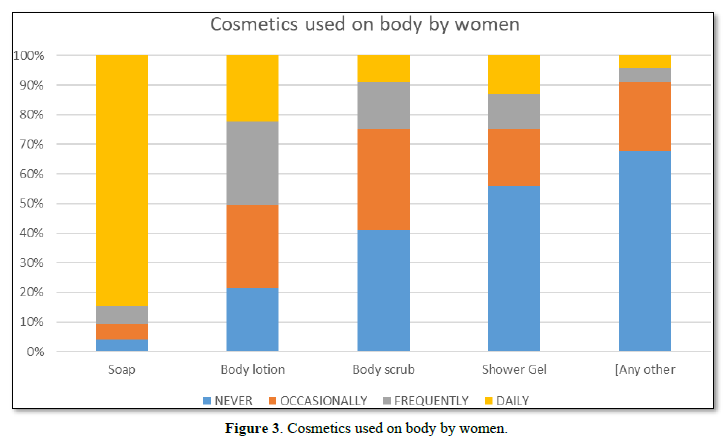
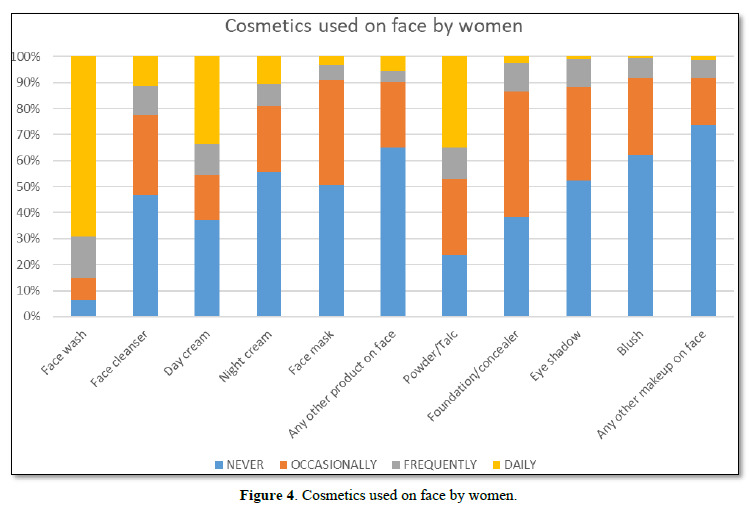
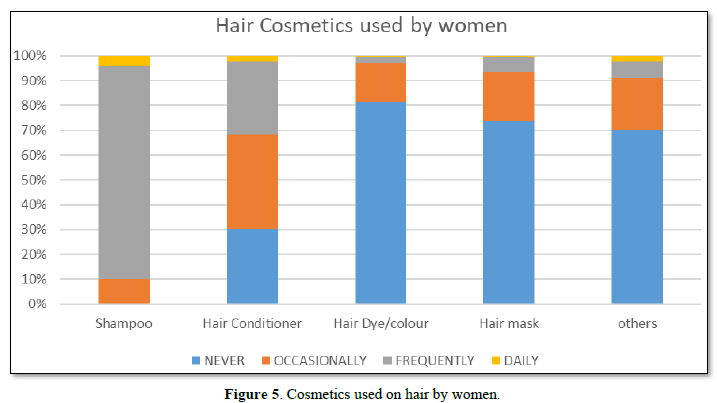

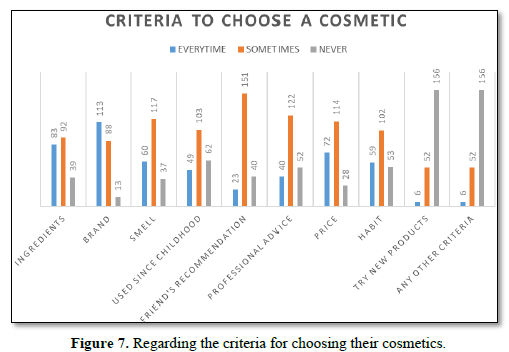
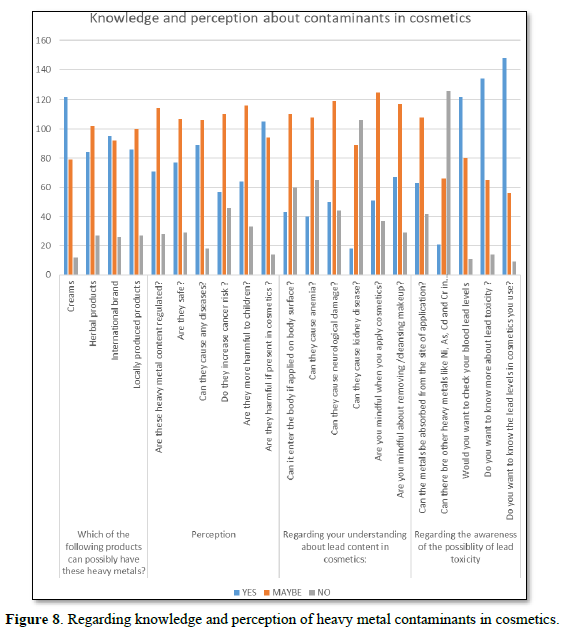
DISCUSSION
Cosmetics and daily personal care products are in use for centuries and they have evolved in many ways. They are universally used by both genders. There have been reports of heavy metals as contaminants from several countries and in varied quantities [1,3,7-11,18-20]. The objective of our study was to assess the knowledge about contaminants in cosmetics, the common practices and to create awareness among young women. Our study population were young, educated, brand conscious and confident as a small group (1.9-3.3%) had concerns about their appearance (Figure 1). Majority of them used personal care products like soaps and face washes on daily basis and occasionally used products on lips, eyes and nails. Majority (about 50%) of women in our study doubted the possibility of contaminants in the products they used. It was difficult to assess whether they had the knowledge or through our questionnaire we were able to induce suspicion. Later in the questionnaire, when there were questions about whether they would want to know more about toxicity with heavy metal contaminants and whether they would want to know the levels of contaminants in their blood and cosmetic products, there was an assertive ‘yes’ by majority of them. Only 9 to 14 of them out of 214 women did not want to check the above (Figure 8). There is a need for creating awareness among both the manufacturing companies, the consumers and the policy makers about the health implications these heavy metals can cause. In the USA, though there is a ban in import of leaded eye cosmetics, there is no effective method to prevent lead exposure to children [14]. It was reported that even the herbs and plants gathered from different localities had toxic levels of lead more than commercially available products [21]. It was attributed to the levels in soil where the plants were grown. In India, the major sources of Pb was from herbal products and cosmetics [22]. With prolonged exposure to minute quantities of heavy metals, they tend to accumulate in the body and cause an imbalance in the normal free radical generation and signal transduction. Both epidemiological and laboratory data suggest that heavy metal induced oxidative stress damage are linked with increased risk of cancer, renal failure, developmental, behavioral and neurological disorders and certain high prevalent non-communicable diseases like diabetes mellitus, infertility, and cardiovascular disease [23]. As the mean age at which they start the use of cosmetics in our study group was very young (11.9 years), there is a likelihood of sequestration of large quantities of harmful heavy metals in the body which will not only affect that person using but also the next generation [19,24]. The heavy metals sequestered in bones may be mobilized to blood in an increased manner due to iron and calcium deficiency, fractures and any kind of stress including pregnancy [25]. As the development of brain occurs most during the neuronal development in utero, it is of utmost need to educate women so that the next generation is not affected by neurological and behavioral disabilities [26]. Lack of awareness can pose an outsized risk to public health and affect other aspects like quality of life, efficiency and productivity of the population at large. The exquisiteness about contaminants in cosmetics generated during this study has led us to suggest newer avenues for exploration and research. Some of which are: consumer education and awareness, regulatory concerns, safer product development and its testing, alternate formulations for cosmetics and long-term health implications.
CONCLUSION
Our observations from this study compels us to believe that there was lack of knowledge among young educated women about the heavy metal contaminants and its health hazards. There is a compelling need to investigate further in larger groups involving all strata of women and men. It is also basic to conduct campaigns at production and regulatory levels to manufacture and market cosmetics and personal care products which have safe levels of contaminants.
No Files Found
Share Your Publication :